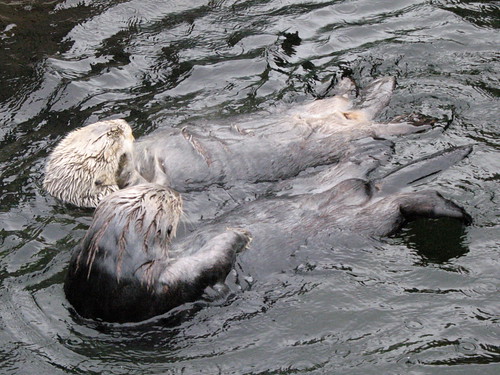I guess part of me thought he’d live forever, or at least long enough to see all the marvels he imagined or predicted. Hell, he saw geostationary satellites and global telecommunications become reality, why not space elevators or Martian colonies or deep-space travel as well?
As a young nerd I read a number of his books: Dolphin Island was first, I think, way back in high school English class, though I haven’t picked it up since. There were also some of the classics, like 2001, Childhood’s End, The Sands of Mars, Rendezvous With Rama (never got into the sequels), The Fountains of Paradise. I loved them all, but my favourite was and still is The Songs of Distant Earth. Almost every page is gold, from the arrival of the Magellans to Thalassa to Moses Kaldor’s discussion of God (a theme Clarke picks up every now and then in his fiction), the conflicts, the heartbreaks, the dramas big and small, as well as the scorps’ evolution to semi-sentience. Like much of his work before and since, Songs shows us a very optimistic future. It’s a future where humanity has grown up, and mostly left aggression and bigotry behind; where we can find peace without sacrificing progress, and without losing our essential nature. A future where race, religion, gender and sexuality are just not that big a deal, and the boundaries of love and family are wider and more flexible.
Lieutenant Horton was an amusing companion, but Loren was glad to get rid of him as soon as the electrofusion currents had welded his broken bones. As Loren discovered in somewhat wearisome detail, the young engineer had fallen in with a gang of hairy hunks whose second main interest in life appeared to be riding microjet surfboards up vertical waves. Horton had found, the hard way, that it was even more dangerous than it looked.
“I’m quite surprised,” Loren had interjected at one point in a rather seamy narrative. “I’d have sworn you were ninety percent hetero.”
“Ninety-two, according to my profile,” Horton said cheerfully. “But I like to check my calibration from time to time.”
The lieutenant was only half joking. Somewhere he had heard that hundred percenters were so rare that they were classed as pathological.
Heh. Yes, it’s completely gratuitous, but Clarke pulls it off, and I can’t tell you what that kind of writing meant to my still-closeted teen self. I like to think it eventually helped me come out to myself, or at least made the way smoother by defusing any internalised homophobia I may have had.
More recently I bought his Collected Stories, a massive sampling of his short stories from 1937 to 1997. Though it’s hard to pick a favourite amongst all these gems, I’m very fond of the “White Hart” stories. Written in the 40’s and 50’s, these take place in the (probably partly real) London pub “White Hart,” a hangout of writers and engineering geeks. These loosely connected tales of university life and improbable inventions, full of dry, low-key British humour, remind me of P.G. Wodehouse’s stories—though with nutty professors and eccentric inventors instead of useless upper-class twits.
I also have to give a special nod to The Wire Continuum, the last one in the collection. Co-written with Stephen Baxter (another fave author of mine), this is a sequel to the very first story in the book, entitled Travel by Wire! A cute but unremarkable story of matter transmission through power lines is re-explored sixty years later as these two stupendously smart and talented minds play at finding applications to this technology. We’re treated to surgical teleportation, faster-than-light communication, instantaneous extrasolar travel and finally, the direct linking of minds leading to an evolutionary quantum leap for humankind. Some of these ideas are further fleshed out in The Light of Other Days, another Baxter/Clarke collaboration.
Finally, there’s an essay of his I reread regularly: “Arthur C. Clarke’s ‘Credo'”, appearing in the September/October 2001 issue of Skeptical Inquirer (one of several specials they did on science and religion). I found it a bit rambling and unfocussed, which I guess is understandable when you’re trying to talk about God and what others have said about God. But the grand vision, gentle humour and warm optimism are pure Clarke.
I began this essay by saying that men have debated the problems of existence for thousands of years—and that is precisely why I am skeptical about most of the answers. One of the great lessons of modern science is that millennia are only moments. It is not likely that ultimate questions will be settled in such short periods of time, or that we will really know much about the universe while we are still crawling around in the playpen of the Solar System.
He concludes by quoting form his earlier book Profiles of the Future: An Inquiry into the Limits of the Possible. I get chills every time I read this passage.
Our galaxy is now in the brief springtime of its life—a springtime made glorious by such brilliant blue-white stars as Vega and Sirius, and, on a more humble scale, our own Sun. Not until all these have flamed through their incandescent youth, in a few fleeting billions of years, will the real history of the universe begin.
It will be a history illuminated only by the reds and infrareds of dully glowing stars that would be almost invisible to our eyes; yet the somber hues of that all-but-eternal universe may be full of color and beauty to whatever strange beings have adapted to it. They will know that before them lie, not the millions of years in which we measure eras of geology, nor the billions of years which span the past lives of the stars, but years to be counted literally in trillions.
They will have time enough, in those endless aeons, to attempt all things, and to gather all knowledge. They will be like gods, because no gods imagined by our minds have ever possessed the powers they will command. But for all that, they may envy us, basking in the bright afterglow of Creation; for we knew the universe when it was young.








